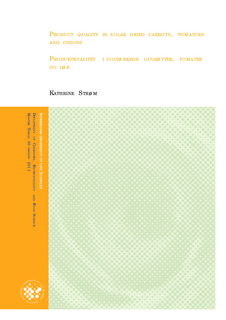| dc.description.abstract | Formålet med denne oppgaven var å undersøke hvordan to ulike typer soltørker påvirket
produktene som ble tørket, og egenskapene som ble undersøkt var vanninnhold, reduksjon i
L-askorbinsyre (L-AA), mineral- og proteininnhold, samt mikrobiologisk aktivitet. De to
tørkene benyttet i forsøket var en kabinettørke kun varmet opp av direkte solenergi med
naturlig luftgjennomstrømning, og en tunelltørke der et solcellepanel koblet til en vifte som
drev luft varmet opp av solen, over produktene som skulle tørkes.
Grønnsakene undersøkt var gulrøtter, tomater og løk. I tillegg til de nevnte undersøkelsene ble
gulrøttene behandlet med ulike typer forbehandling for å se hvordan dette påvirket
rehydrerings evnen og utseende på de tørkede prøvene. Tomatene ble tørket både som skiver
og båter for å se om det var mulig å produsere større biter av tomatene, da dette kunne vært et
nytt produkt på det lokale markedet.
Resultatene viste at det var en signifikant korrelasjon mellom vanninnhold og type tørke brukt
og produktene tørket raskere ved bruk av tunelltørken. Det var høyere mikrobiologisk
aktivitet i prøvene fra kabinettørken, og begge de nevnte faktorene kan ha vært et resultat av
høyere temperatur og lufthastighet i tunelltørken. Det ble også funnet vekst av koliforme
bakterier i noen av prøvene, og det kunne tyde på for dårlig hygiene ved behandling av
prøvene. Mugg og/eller gjærvekst ble sett i alle prøvene og dette kan være uheldig, da enkelte
muggarter kan danne toksiner under gunstige forhold.
Høyere temperatur var antagelig også grunnen til at høyere degradering av L-AA ble
observert i prøvene fra tunell tørken. Mineral og proteininnholdet i prøvene viste ingen klare
forskjeller mellom prøvene fra de to tørkene, men proteininnholdet kunne se ut til å være noe
høyere i tomatprøvene fra tunelltørken, sammenlignet fra samme prøver tørket i kabinettet.
Når en sammenlignet resultatene fra mineral analysen av grønnsakene i dette forsøket med
verdier oppgitt i matvaretabeller fra Norge og Tanzania, varierte mineralinnholdet i retning
høyere innhold av enkelte mineraler i noen av grønnsakene, mens verdiene var lavere for
andre mineraler og grønnsaker. Jordsmonnet grønnsakene ble dyrket i kan ha påvirket dette
utfallet. The purpose of this thesis was to investigate how two different types of solar dryers affected
the products that were dried, and the properties examined were water content, reduction in Lascorbic acid (L-AA), mineral- and protein content, and microbiological activity. The two
dryers used in the experiment was a cabinet dryer heated by direct solar energy and a tunnel
dryer with a solar panel connected to a fan who forced air heated by the sun, over the products
to be dried.
The vegetables studied were carrots, tomatoes and onions. Contents of L-AA, minerals and
proteins were examined and the microbiological quality of the products was evaluated. In
addition to the aforementioned studies were the carrots treated with various degree of pre
treatment to see how this affected the rehydration ability and appearance of the dried
samples. The tomatoes were dried both as slices and boats to see if it was possible to produce
larger pieces of tomatoes, as this could be a new product in the local market.
The results showed that it was a significant correlation between moisture content and type of
dryer used, and the products dried faster when using the tunnel dryer. There was a higher
microbiological activity in the samples from the cabinet dryer, and both these factors could
have been the result of higher temperature and air velocity in the tunnel dryer. It was also
found growth of coliform bacteria in some of the samples, which could indicate inadequate
hygiene in the treatment of the samples. Mold and/or yeast growth was seen in all samples
and this may lead to the presence of toxins produced by certain mold species. This growth
was consistent with previous studies of mold growth in dried products.
Higher temperature was probably also the reason for why higher degradation of L-AA was
observed in the samples from the tunnel dryer. Mineral and protein content of the samples
showed no clear differences between the samples from the two driers, but the protein content
could appear to be somewhat higher in tomato samples from the tunnel dryer, compared with
the same samples dried in the cabinet. When the results of the mineral analysis of the
vegetables in this experiment was compared with the values given in food tables from
Norway and Tanzania, some of the samples showed higher levels of certain minerals in some
of the vegetables, while values were lower for other minerals and vegetables. The soil
conditions where the vegetable was grown may have influenced this outcome. | no_NO |
